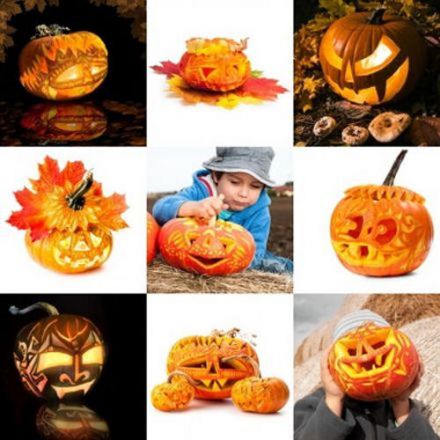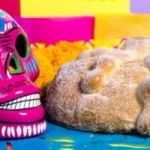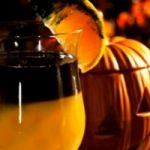
Hoo hoo! Hoo hoo! Do you know where the Hallowe'en tradition of the pumpkin comes from? The word Halloween, first of all, is a shortened form of "All Hallows' Eve."
The ancient Celtic festival of Samain, which dates back more than 2,500 years, is considered the ancestor of Halloween. It took place on the final day of the Celtic calendar. It was a celebration of the end of the harvest and marked the start of the long sleep which nature was entering. The Celts believed that on Samain night the border between the worlds of the living and the dead would be opened and that spirits would visit the living. To ward them off, the Celts lit big bonfires. In the Middle Ages, they began making smaller fires (keeping the smaller ones for witches!). Today, the custom lives on, but the fire has been reduced to a candle placed inside a pumpkin - and instead of being afraid, we have fun scaring ourselves!
The festival of Samain, celebrated in Scotland and Ireland, was eventually replaced by All Saints' Day, assigned to November 1 by the Catholic church about the 8th century. It was only in the mid-nineteenth century that Halloween became the spooky holiday we know today.
In that era, Irish and Scottish immigrants were arriving on the new continent, fleeing the famine in Ireland, and bringing with them their fables and legends. Since then, Halloween has been celebrated in the US, Canada, Australia, Ireland and Great Britain. In France, Halloween celebrations didn't begin until the late 1990s, although they haven't caught on as they have overseas, in part because the holiday is deemed too commerical by its detractors.
Today, the symbol of Halloween is the pumpkin, but that hasn't always been the case. This vegetable is a nod to the Irish legend of the Jack O'Lantern. According to legend, Jack, a lazy drunkard, defies the devil. When he dies, neither heaven nor hell wants to let him in. Jack is condemned to wander the shadows for eternity, lighting his way with a candle stuck inside a hollowed-out turnip. Jack reappears every year on the day of his death: Halloween. Over the years, the turnip was gradually replaced by the bigger and easier to carve pumpkin.
This year, turn your pumpkin on its side, roll it around and think up a new face. Look! Its big green stem makes a great nose. Create an expression based on the pumpkin's shape: a hooked nose can make a terrifying face; a nose in the air can become a child in open-mouthed surprise; a nose to one side suggests a crooked face… and so on.
Play with the shape of the eyes and mouth. Add a couple of coffee beans to make the pupils, or maybe even some almonds at the top or bottom of the mouth to create teeth.

Halloween carrot cupcakes (allergy-free)
Gratinéed French Toast with Pumpkin Compote

Ireland
Halloween in Ireland always involves dressing up in scary costumes, wandering through the streets in search of treats, and eating big slices of Barm Brack! Such is the fate of this typically Irish fruit bread, served every October 31st to the delight of young and old. For the occasion, candied fruit, zest and almonds are added to the dough, and - because it's a day of celebration and we're in Ireland - 50 ml of the macerating tea is replaced with good whiskey.
There is also Colcannon, a mashed potato purée with kale, which is traditional for Halloween. It must contain a plain gold ring, a sixpence, a thimble or a button.

On November 2, Mexico celebrates the Day of Dead (Dia de muertos) when they like to eat a special sweet bread called “Pan de muerto” (bread of the dead) that is decorated with little bread bones, and drink Cafe de olla.

In Ecuador on November 2, the Day of the Dead (Dia de los difuntos), peasant families go to the cemetery dressed in their finest clothes to decorate the graves with their loved ones' favorite images and objects. They gather around them, then spread out a cloth on which they place their cucayo (food in Quechua).
Cucayo is a sampling of traditional foods of their ancestors: grains, roast guinea pig, pork, fingerling potatoes (mellocos), beans, cooked corn leaves, not to mention a pitcher of chicha (a fermented corn-based drink), all rounded out by "guagas" (baby in Quechua): little bread figures shaped like swaddled babies, accompanied by colada morada, a traditional thick drink made from purple corn, fruits, spices and herbs.
While they share their meal, they take the opportunity to tell the dead the family news, pray, ask them for advice, and thus spend the day talking together, asking for their help and protection in the year to come.

Transform your pumpkin into a clever drink cooler, an impromptu soup tureen, or a table centerpiece for Halloween or your fall party.

The Ghost, an espresso martini recipe to raise the dead

-

 Recipes
Recipes
-

 Products
Products
-

 Entertaining
Entertaining
-

 Chefs
Chefs
-

 Hints & Tips
Hints & Tips
-

 Glossaries
Glossaries










